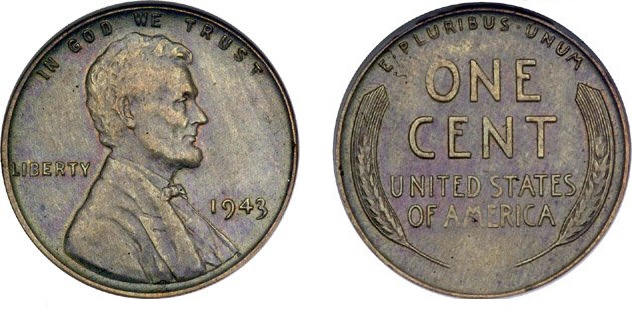Magnetic Copper
Drop a magnet into a pile of U.S. pennies and not a whole lot is going to happen. Pennies are made up of 97.5% zinc and 2.5% copper, and neither of those two metals are magnetic. You should be able to remove the magnet without any of those pennies sticking to it. But if a cent or two happen to come along for the ride, you may have been the victim of fraud.
That’s the bad news. The good news? You may be a few dozen cents or so richer than you thought you were.
That’s because in World War II, the government needed copper for ammunition and military equipment, and putting copper into pennies seemed like a huge waste. Many alternatives were tested, and, ultimately, the U.S. Mint went with steel. On occasion, you’ll find a 1943 penny made up of 99% steel and the rest zinc. It’s a relatively rare coin because the Mint destroyed many of them before the decade was out, but there are enough floating around out there that if you really want one, you can typically find them for 50 cents apiece or so online. And as seen on that link, the 1943 steel pennies are a silvery-white color, unlike the color of a typical penny. Steel is magnetic, and therefore, so are 99% steel pennies.
Your bronze-ish penny sticking to that magnet? If it says 1943 on the front, that’s almost certainly what you have.
When the Mint produced the 1943 steel cents, it also made a handful of mistakes. Forty mistakes, give or take. Those mistakes are known as the 1943 copper penny, as pictured. They should have never been made.
In general, to create coins, the Mint puts round metal slugs called planchets through presses. The presses imprint the design onto the planchets. When the Mint ran off the 1943 line, they did so using steel planchets, as discussed above. But for some reason, all three Mints — Denver, Philadelphia, and San Francisco — are believed to have made the same tiny mistake at the start of the process. Each of the three neglected to clear the last few remaining copper planchets off the press. So there are a handful of 1943 pennies out there which, like pennies minted in other years, are made of copper. But because of the war, they were supposed to be made of steel.
The 1943 copper pennies looked like their predecessor coins, and because there were so few of them, the Mint didn’t notice the error or, perhaps, didn’t think to do anything about the handful of erroneous cents now in the monetary system. The mistake wasn’t discovered by collectors until 1947. The U.S. Mint notes that only about 40 of the coins were ever minted and there are only (already?) 12 confirmed to exist and have been located. There are perhaps as many as 200 billion normal pennies currently in circulation, so your odds of finding one of the 30 or so potentially floating around out there are one in fifteen billion. Due to its rarity, an actual 1943 copper penny is worth tens of thousands of dollars, if not more.
Which is why fraudsters try to trick the unsuspecting coin collector. There are lots of fake 1943 copper pennies out there. Some fraudsters find 1948 pennies and shave down the 8 to look like a 3, easily fooling amateurs. More common, though, are those who buy 1943 steel cents and plate them with copper, making them look like the super-valuable one. That’s easy enough to detect — those, unlike true copper pennies, are magnetic after all. So if your magnet picks up a penny, it may be because someone tried to pass off a phony 1943 copper cent. It’s still worth about 25 cents or so, so don’t be too upset.
Bonus Fact: There’s one penny which is probably less attainable than the 1943 copper pennies out there. It’s a 1909 penny — the first year Abraham Lincoln’s portrait graced the coin — and it’d take you the better part of a year and billions of dollars to go and get it. That’s because it’s on the Mars Curiosity Rover, as part of the camera calibration system.
From the Archives: From Abe to Zinc: The cost of making and distributing a penny? At least 50% more than a penny.
Related: Steel pennies.

